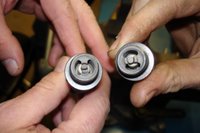Annual

It was time for the annual inspection on 6G, and so I went up with Dad to see our C172 with all of the access panels open. We had the work done at Missionary Maintenance (MMS). I have helped a friend of mine pound thousands of rivets together to build an RV-6, so I had some inkling of what the internals of a general aviation aircraft looked like. It was pretty interesting - really, there's not too much to a Cessna but the airframe, a simple carbeurated engine, a vacuum system, an alternator, and some flight controls.
I have been around large commercial aircraft undergoing A, B, and C checks at Mexicana, Northwest Airlines, Air Canada, Delta, Aer Lingus, and others, and so I have spent a fair amount of time in aircraft shops, and I have to say that I was very impressed with the thoroughness of MMS. They really take a lot of time and seem to really pay a great deal of attention to small details. Of course, the annual inspection is a thorough process as mandated by the FAA, but you can tell the difference between someone that takes their job seriously and someone who is punching a time clock. I was impressed.
Here are a few photos of the airplane through the inspection...

C172 Cockpit with the seats removed, looking through the cargo door.

You can clearly see erosion of the used sparkplug versus the newer one.

View looking down the inside of the fuselage towards the tail.

Powered by Lycoming! A closeup of the cylinder head on the O-320.
 Sunrise at London Heathrow (LHR)
Sunrise at London Heathrow (LHR) Big row of heavys!
Big row of heavys! A321 wings are a long ways off the ground!
A321 wings are a long ways off the ground! Right hand drive diesel VW Passat. Does it get any better?
Right hand drive diesel VW Passat. Does it get any better? Brake overhaul training
Brake overhaul training